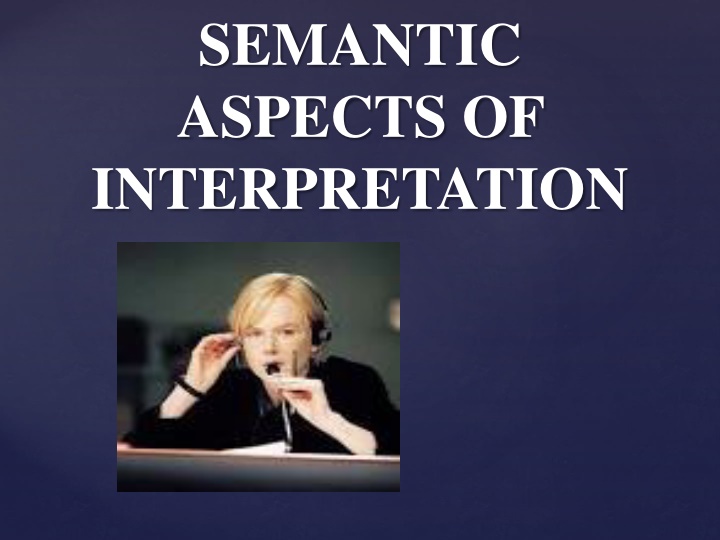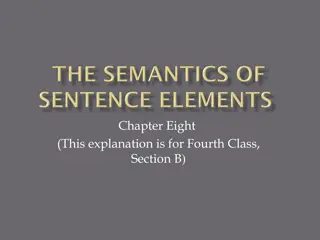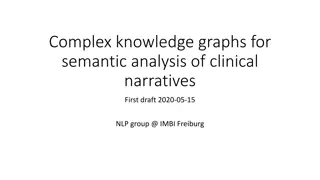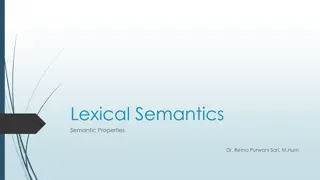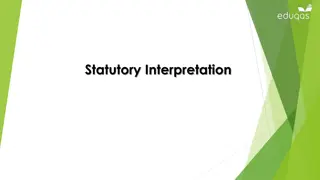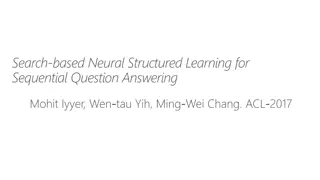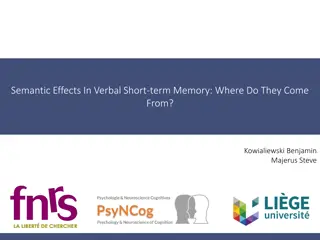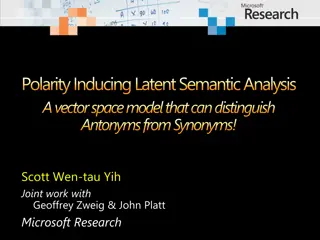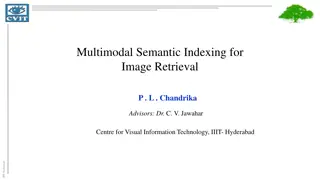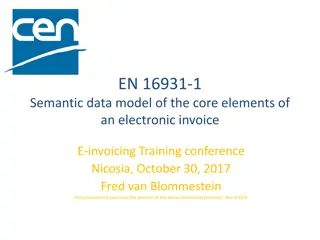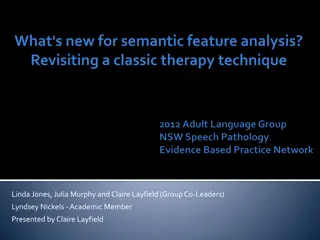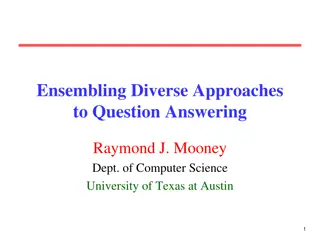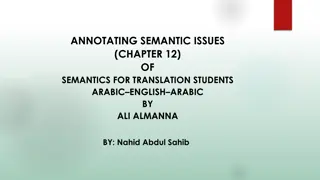Semantic Aspects of Interpretation
Explore the semantic structure of oral messages, distinctions between meaning, sense, and semantics in linguistics, and the role of context in interpreting linguistic units. Discover how interpreters render sense in speech acts, the proposition as a picture of the world, and the components of verbal messages. Uncover the explicit and implicit elements in messages and their essential components in communication.
Uploaded on Oct 04, 2024 | 2 Views
Download Presentation

Please find below an Image/Link to download the presentation.
The content on the website is provided AS IS for your information and personal use only. It may not be sold, licensed, or shared on other websites without obtaining consent from the author.If you encounter any issues during the download, it is possible that the publisher has removed the file from their server.
You are allowed to download the files provided on this website for personal or commercial use, subject to the condition that they are used lawfully. All files are the property of their respective owners.
The content on the website is provided AS IS for your information and personal use only. It may not be sold, licensed, or shared on other websites without obtaining consent from the author.
E N D
Presentation Transcript
SEMANTIC ASPECTS OF INTERPRETATION {
1. Semantic Structure of the Oral Message and its Main Components
Linguistics distinguishes between the notions of meaning, sense and semantics.
Meaning of linguistic units is usually described as their contents reflected in the respective dictionaries or grammar books. The notion of sense goes outside pure linguistics and has to do, first of all, with 1) the context and communication (the communication, aims of participants, their background knowledge, etc.) 2) situation field of of subject
sense Therefore units comes to life in real speech as a result of relations established between meanings of linguistic units and situations. of linguistic communicative
Indeed, it is practically impossible to translate such words as: challenge, benchmark, network, intervention, , , until the word is placed in the context and until predication (i.e. proposition) takes place. event, cohesion, the act of a creation of
Therefore, interpreters render the sense of linguistic units, which is generated in each particular act of speech as a result of producing messages by the speakers.
Messages, both written and oral, have certain semantic main element of proposition, in other words a "picture" of the world, a "statement" about the world, which may be true or false, which is (normally) pronounced with a certain purpose, and which the subject and the predicate (elements of the predicative group) structure, which the the is (normally) has
Verbally expressed (explicit) hidden implicit Messages must contain the following components
The deictic component: orientation of the message with regard to the "person", "space" and "time": e.g. I warn you that it is probably cold outside
The modal component: treating the proposition of the speaker as possible, impossible, desired, mandatory, unnecessary, likely, doubtful etc.: e.g. I warn you that it is probably cold outside
The evaluative component: positive or negative evaluation of the elements of the speaker's proposition (or "zero evaluation"): I warn you that it is cold (negative evaluation) outside, so, since you are unwell (negative evaluation), you'd rather wear your warm (positive evaluation) sweater
The pragmatic component: indicator of the aim of pronouncing the utterance (communicative intention) as it is viewed by the speaker: e.g. I warn (the act of warning) you that it is cold outside.
Conclusion: It is quite obvious that for interpretation to be successful it is not enough to translate only the "propositional element" of the message but also to render all other components of its semantic structure, thus ensuring that it "makes sense" for the listener and produces desired effect upon him/her.
1.2. Semantic Redundancy. Interpreter s Note-Taking
Semantic redundancy ( ) is an important property of any speech, especially oral one. It provides safeguards for successful transmission of information, i.e. ensures that the listener better understands the speaker and that the communicative intent of the speaker is achieved.
The phenomenon of semantic redundancy of speech makes it possible for interpreters to use the techniques of universal interpreter's note-taking (UINT) of oral messages in consecutive interpreting. The main purpose of UINT is to create focuses of information for further subsequent "extraction" or "unpacking" the information by the interpreter.
Interpreters' alternative to standard stenography (shorthand), dates back to the Geneva University School of Interpreters set up under the auspices of the League of Nations in 1941. Detailed description of interpreter's note- taking and practical recommendations on its application started to develop rapidly since J-F. Rozan's epoch-making book on note- taking "La prise de notes, en interpretation consecutive" (Geneva, 1956).
In the former Soviet Union principles of note-taking were first suggested by R.K.Minyar-Beloruchev in his book on consecutive interpreting. Principles and methods of interpreter's updated version of note-taking were further on developed by A.P. Chuzhakin, O.V. Rebriy.
For example, the notes in the illustration might be interpreted to mean : We are particularly glad to inform you about an important increase in our company s revenues, which rose by 10 percent from 3.5 to 3.85 billion dollars. This derives from huge sales of helicopters. The United States of America bought 50 and South Africa 20 of them. On the other hand, we must relocate parts of our production in these countries.
Main principles of the interpreter's note- taking may be summarized as follows: 1. Each interpreter makes a choice according to his/her preference on how to apply IN; 2. IN creates safeguards for keeping in memory "precision" lexicon (dates, numerals, proper names, abbreviations, etc).
3. IN usually does not record separate words, but rather registers ideas, logical links, evaluation and modality. 4. Notes in IN are made in "a diagonal staircase" format either in the source or in the target languages, or
in a "mixed" way in the following sequence: a) the subject group; b) the verb-predicate group; c) the object (direct and indirect) group; d); e); f), etc. - adverbial modifiers and other parts of the utterance.
5. IN is based on a system of symbols and abbreviations, easy to remember, write down and decipher from the context. This system may be briefly described as follows: a) extensive use of commonly accepted abbreviations, acronyms and symbols, like: UN, UNESCO. WHO, WTO, NATO, OSCE, CEO
, ( ), , , M3C, MBC, , BP (for ), $, , UAH, , etc;
b) occasional individual interpreter's shortenings, like: K (for Kyiv); Kmin (for the Cabinet of Ministers); bge for he did not go, E (unemployment); E for unemployment, dr for draft, bdg for budget, for , for , for , etc;
c) logical and modal links are marked by symbols, like: : - to say; OK- to approve, to support; OK - to condemn, to disapprove, to reject; - today, at present; > - more; < - less; d (must, to be to, to have to, should) - obligation; n (need) - necessity; c (can), c? (could) - possibility;
d) the plural form is indicated by 2; and the "very" by 3; e) other commonly used symbols: <- obtain, receive, attract; -> -send, give, arrive; <- E - export; - approximately; ! - danger, threat or emphasis on something
M - peace; -democracy; -life; - party; Eco - environment, ecology; X - war; P -policy, political; (b+) - budget surplus
f) numerals are marked like: t - thousand; m - million; b - billion; tr -trillion; g) dates are indicated as follows: 17.10.07 - 17 October 2007; days of the week may be either commonly abbreviated: - Monday; tue - Tuesday, fri - Friday, sun - Sunday, or marked by a corresponding encircled number of the day
h) blocks of utterances which make up a complete thought and are to be interpreted are usually separated by horizontal lines, or encircled;
i) combinations of arrows, lines, circles, parenthesis or abbreviations at their own discretion, provided there is a guarantee that they remember the "encoded" meaning of these symbols and do not overload their memory with the "third" meta-language of interpreter's note-taking. interpreters may use other
MP2BP OK dr bdg 07 (2 ) tue
Note-taking skills is a powerful instrument capable to increase the volume of information rendered and to ensure higher precision of interpreting. This is especially important in consecutive interpreting when interpreters have to keep in memory long units of information and when taking notes is the only way of supporting interpreter's memory
